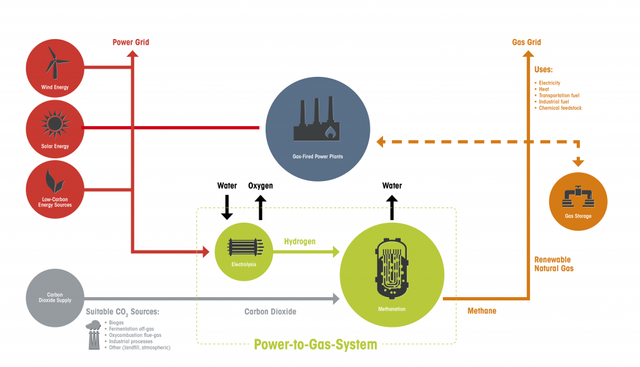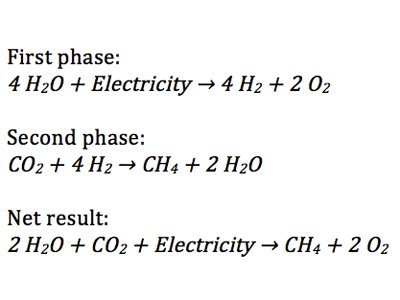Startup University of Chicago converts renewable energy into methane by microorganisms
One of the main obstacles to the widespread implementation of solar panels and wind turbines - no way to store excess energy they produce. Power-to-gas - a technology developed at the University of Chicago, refers to the unstable nature of these renewable sources. It uses single-celled organisms that scientists have deduced by selection. Microorganisms help convert methane into electricity - a gas which can be stored, transported and used anywhere, where natural gas is used, including for power generation on demand.
In the center of power-to-gas technology is a strain of archaea methane-adapted for industrial use. Methanogenesis begins with surplus electricity produced by a wind turbine or solar panel, but at this point unnecessary. This energy is used to convert water into hydrogen and oxygen. Then, hydrogen is combined with carbon dioxide derived from any source, in its own bioreactor, which catalyze the conversion of a mixture of organisms into methane and water.
Conversion to the methane
Further, methane can be transported into an existing pipeline system or converted to compressed or liquefied natural gas suitable for the production of electricity. Technology creator Laurens Mets said that it offers greater potential capacity - more than competing systems wholesale energy storage: batteries, pumped-storage hydroelectricity, compressed air systems, and gravitational energy storage. When using all of these systems, the efficiency loss is inevitable, and the creators of power-to-gas is not called efficiency of the process.
The technology allows you to increase the use of volatile in nature energy sources such as wind and sun. If you store the excess energy, thus you can smooth out these fluctuations and to make renewable energy sources more feasible and economically viable.
Scientists believe the potential of the patented power-to-gas technology is of great importance. Methane - the simplest hydrocarbon, which has received very widespread: it's warm water and food, rides transport, and there are even rocket engines running on this gas. Methane is fully compatible with the existing gas network, and it can become a major source for most of the energy needs of society, including electricity, heating, industrial processes and transportation. A reliable way to create pure methane from renewable sources has the potential to transform the existing energy systems.
Lawrence Mets continued their studies at the university and aims to improve its technology. He hopes to adapt the power-to-gas to produce gasoline and jet fuel.
Doctoral student of molecular genetics and cell biology Lawrence Mets engaged in the development of technology in the late 1990s. In the future development of the Mets, with the support of university technology transfer center, which is now part of the Polish Business and Innovation Center, I was born startup Electrochaea.
Electrochaera placed in the top 100 private companies with the greatest potential to solve the energy crisis in 2014 Global Cleantech 100. Created in 2006, the first startup Electrochaea tested the viability of the process in his laboratory in St. Louis. To start testing the power-to-gas in 2011.
Three years later Electrochaea started construction of a large-scale demonstration facility at the station for waste water treatment near Copenhagen under the Biocat project. Building on the success of this project, the company decided to build a 10-megawatt power plant in Hungary, where the technology is power-to-gas will be realized.
«Electrochaera develops very quickly, in a few steps we went from 1-liter reactor in my university lab to the first 1-megawatt project Biocat, and is now building a 10-megawatt commercial plant in Hungary. The microorganisms were really hardy, "- said the Mets.
Hungary plant will be built and Electrochaea Magyar Villamos Muvek - the largest supplier of energy in this country. As in the case of Biocat, the new plant will supply methane directly to the existing gas pipeline system.
Electrochaea plans to build another plant in Switzerland 1000MVt settings. Meanwhile Pasific Gas and Electric Company is building a small demonstration facility at the National Renewable Energy Laboratory in Colorado.


Nice discussion of this new renewable energy technology. Finding ways to store the excess energy produced both by renewable sources as well as the existing grid are essential to an effective energy grid, and our ability to shift away from fossel fuel use. Great post and nice explanation of the methodology!
As a bonus, and in addition to resteeming for exposure. We are awarding you a small 5 Steem Power deposit as a thank you for creating quality STEM related postings on Steemit. We hope you will continue to educate us all!
https://steemit.chat/channel/steemSTEM
This guy has done a similar thing with solar to hydrogen cells.
http://hydrogenhouseproject.org/
Nice post, very interesting!
We should see more of these ideas for alternative energy spread. Energy is in some sense our future.
Your post has been chosen by the @robinhoodwhale initiative as one of our top picks today.
Learn more about the Robinhood Whale here!
The Steemit community looks forward to more great stuff from you. So, please keep on Steeming!
Good luck!
~RHW~